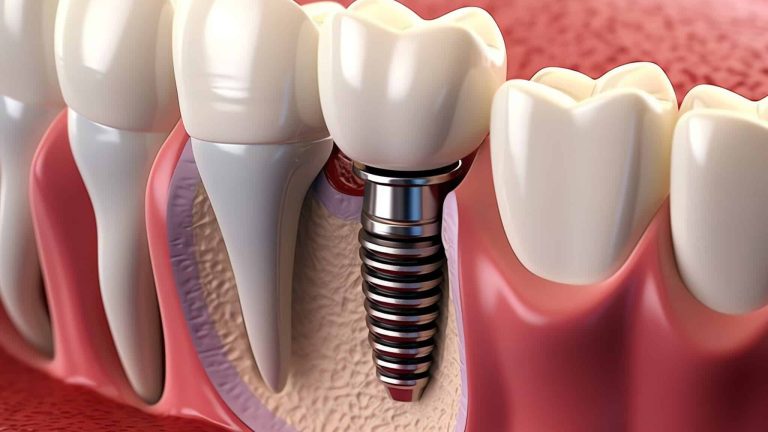Tooth loss is a problem that affects millions of people worldwide, with causes ranging from accidents or trauma to diseases like periodontitis. For many, this situation not only leads to aesthetic concerns but also functional issues, affecting the ability to eat, speak, and smile with confidence. Fortunately, dental implants have revolutionized dentistry by offering an effective, permanent, and natural solution to restore both the functionality and aesthetics of a complete smile.
In this article, we will explore in-depth what dental implants are, how they work, their long-term benefits compared to other alternatives like removable dentures, and why they represent an investment in the patient’s health and quality of life. We will also showcase a real success story, complete with before and after images, so you can see the transformative impact of this treatment.
What are Dental Implants?
A dental implant is an artificial titanium root surgically inserted into the maxillary or mandibular bone to replace the root of a lost natural tooth. This device serves as a base to support a dental prosthesis, whether it be a crown, bridge, or complete denture, depending on the patient’s needs.
Titanium is the preferred material due to its biocompatibility, meaning the body does not reject it, and its ability to fuse with bone through a process called osseointegration. This process is crucial for the stability and long-term success of the implant, ensuring it becomes an integral part of the bone structure.
Components of a Dental Implant
A typical dental implant consists of three main parts:
- The implant (or titanium screw): The piece inserted into the bone, acting as an artificial tooth root.
- The abutment: This connects the implant to the visible dental prosthesis.
- The crown (or dental prosthesis): The visible part that mimics the natural tooth.
How Does a Dental Implant Work?
The dental implant procedure is done in several stages, ensuring the body accepts the implant and that the treatment is successful in the long term. Here are the typical steps of the process:
1. Initial Evaluation and Planning
Before proceeding with the treatment, a thorough evaluation of the patient’s oral health is conducted. This includes clinical exams, X-rays, and sometimes computed tomography (CT) scans to assess the amount of bone available in the jaw and ensure the implant can integrate properly. If the patient lacks sufficient bone, a bone graft may be necessary to strengthen the area before implant placement.
2. Implant Placement
Once the patient is determined to be a good candidate for the procedure, the dentist or oral surgeon makes an incision in the gum to expose the jawbone. The titanium implant is inserted into the bone, and the gum is sutured. Over the next few months, the implant fuses with the bone in the process of osseointegration.
3. Abutment and Crown Placement
After the implant has integrated with the bone (usually 3 to 6 months after surgery), an abutment is placed on the implant, which will support the crown. The crown is custom-designed to match the color and shape of the patient’s natural teeth, providing an aesthetic and functional result.
4. Rehabilitation and Follow-Up
Once the crown is placed, the patient can enjoy their new smile. However, regular follow-up appointments with the dentist are necessary to ensure the implant is functioning properly and to detect any potential issues early on.
Long-Term Benefits of Dental Implants Compared to Other Alternatives
Several options exist for replacing missing teeth, including removable dentures and fixed bridges. However, dental implants offer numerous long-term advantages, making them the best option for many patients.
1. Durability and Longevity
Dental implants are designed to last a lifetime with proper care. Unlike removable dentures that may need to be replaced every 5 to 10 years, implants, once integrated with the bone, provide a permanent solution. This not only reduces long-term costs but also minimizes the discomfort of having to replace or adjust the prosthesis.
2. Improved Bone Health
When a tooth is lost, the bone that once supported it begins to deteriorate due to lack of stimulation. Dental implants mimic natural tooth roots, meaning they stimulate the jawbone and prevent bone loss. This is not the case with removable dentures, which do not provide any stimulation to the bone.
3. Comfort and Functionality
Unlike removable dentures, which can shift or slip while speaking or chewing, dental implants are firmly anchored into the bone, providing greater comfort and functionality. Patients can eat their favorite foods without fear of their dentures moving or causing pain.
4. Natural Appearance
One of the main concerns of patients who have lost teeth is the aesthetic impact. Dental implants offer a solution that looks and feels like a natural tooth. The crown is matched to the color and shape of the surrounding teeth, allowing patients to regain confidence when smiling, speaking, and socializing.
5. Simple Maintenance
Dental implants do not require special care beyond good oral hygiene. Brushing, flossing, and attending regular dental checkups are sufficient to keep the implants in good condition. In contrast, removable dentures may require special cleaning products and more effort in daily maintenance.
Dental Implants vs. Removable Dentures: Which Option Is Better?
To better understand the advantages of dental implants, it is helpful to compare this option with removable dentures, one of the most common alternatives for replacing missing teeth.
| Feature | Dental Implants | Removable Dentures |
|---|---|---|
| Durability | Lifetime durability | Requires replacement every 5-10 years |
| Comfort | Firm and stable, like a natural tooth | Can shift, causing discomfort |
| Functionality while eating | No restrictions | May limit certain foods |
| Impact on bone health | Prevents bone loss | Does not stimulate bone, leading to deterioration |
| Aesthetic | Natural look and feel | Often less aesthetic and bulkier |
| Maintenance | Simple maintenance (like a natural tooth) | Requires special products and additional care |
It is clear that dental implants are a superior long-term option in terms of comfort, durability, and preservation of bone health.
Success Story: The Impact of Dental Implants
A patient came to Clínicas La Guardia after losing several teeth, which affected their ability to eat properly and caused insecurity when smiling. After a thorough evaluation, dental implants were determined to be the best option to restore their smile.
Before:
The patient had visible gaps in their upper teeth, with significant bone deterioration due to prolonged tooth loss.
After:
Dental implants were placed in the affected areas, followed by crowns that seamlessly blended with the rest of their natural teeth. The patient regained confidence and full mouth functionality, greatly improving their quality of life.
The success of this treatment was not only in the aesthetic improvement but also in restoring chewing function and preventing future oral health issues, such as further bone loss.
Conclusion: Dental Implants, An Investment in Your Health and Quality of Life
Dental implants are much more than an aesthetic solution. They represent a long-term investment in oral health and quality of life, allowing patients to enjoy a functional, comfortable, and natural smile for the rest of their lives. Although the process requires time and dedication, the benefits are incomparable, offering a permanent solution over the limitations of removable dentures.
At Clínicas La Guardia, we are committed to providing you with the most advanced solutions in dental implantology so you can regain your smile with confidence. If you are interested in learning more or scheduling a consultation, do not hesitate to contact us. Your smile is our priority!



